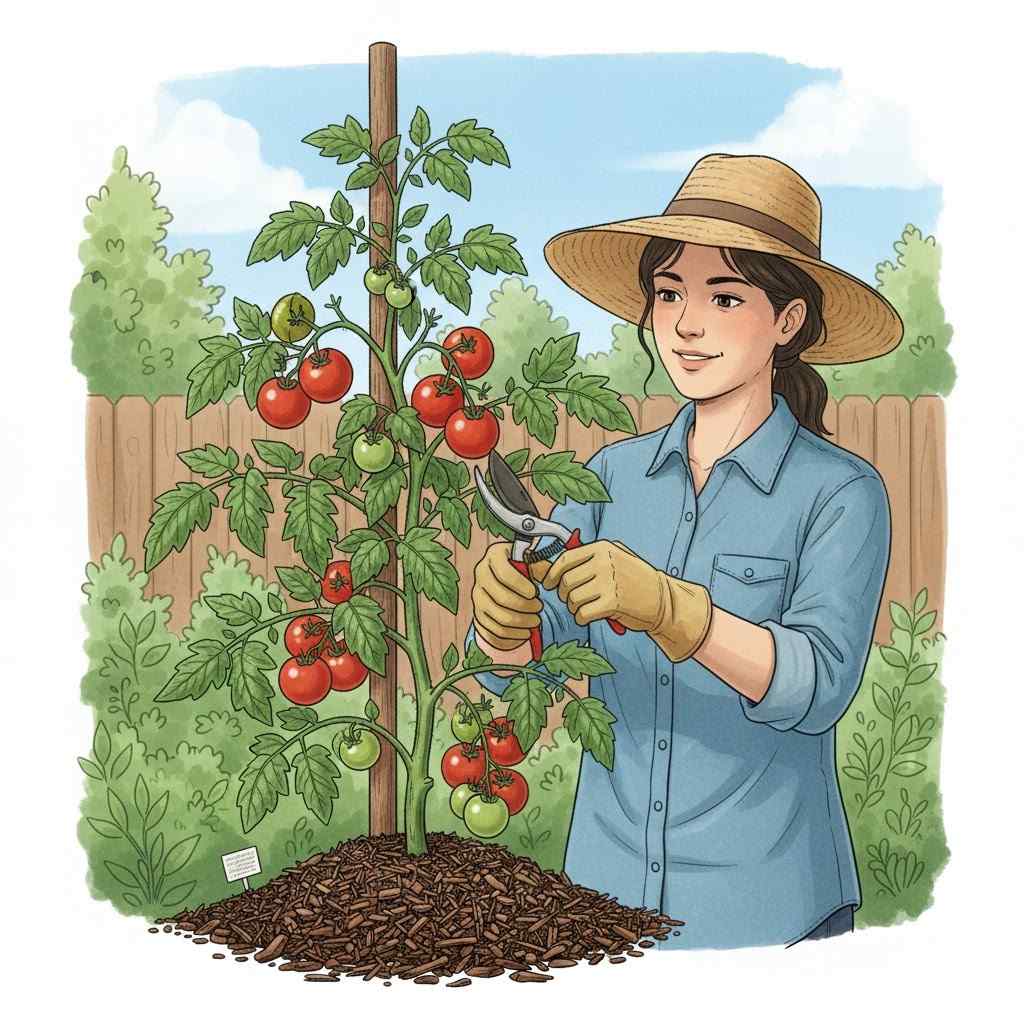Pruning tomato plants is a game-changer for home gardeners aiming for healthier plants, bigger yields, and tastier fruits. While it might seem intimidating at first, pruning is a straightforward skill that anyone can master with the right guidance. This comprehensive guide dives deep into why, when, and how to prune tomato plants, tailored for beginners. Expect step-by-step instructions, practical tips, common mistakes to avoid, and seasonal advice to ensure your tomatoes thrive.
Why Prune Tomato Plants?
Pruning involves selectively removing parts of a tomato plant—such as leaves, suckers, or stems—to improve its health and productivity. Here’s why it’s worth your time:
- Boosts Fruit Production: Pruning directs the plant’s energy toward producing larger, juicier tomatoes instead of excessive foliage.
- Improves Air Circulation: Removing crowded leaves reduces the risk of fungal diseases like blight, which thrive in damp, stuffy conditions.
- Enhances Sunlight Exposure: More light reaches the fruits, speeding up ripening and improving flavor.
- Controls Plant Size: Especially for indeterminate varieties, pruning keeps plants manageable, ideal for small gardens or containers.
- Prevents Pests: Fewer dense leaves mean fewer hiding spots for pests like aphids or spider mites.
Data backs this up: studies from agricultural extensions, like the University of California, show that properly pruned tomato plants can yield up to 25% more fruit compared to unpruned ones.
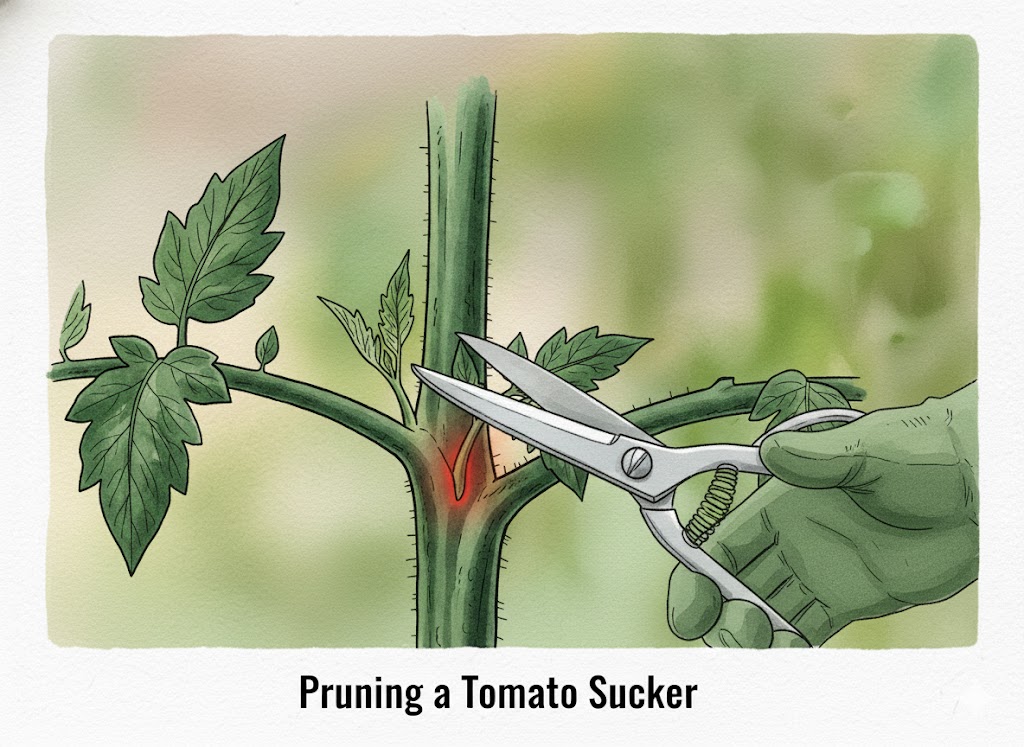
Understanding Tomato Plant Types
Before pruning, know your tomato variety, as it affects how you prune:
- Determinate Tomatoes: These are bushy, compact plants that stop growing at a certain height (usually 3-4 feet). They produce all their fruit at once, so pruning is minimal to avoid reducing yield. Examples: Roma, Celebrity.
- Indeterminate Tomatoes: These keep growing and producing fruit until frost, often reaching 6-10 feet. They require regular pruning to manage growth and maximize yield. Examples: Beefsteak, Cherry, Heirloom varieties.
Check your seed packet or plant label to confirm the type, as this guides your pruning strategy.
When to Prune Tomato Plants
Timing is critical for effective pruning:
- Early Season (Seedling Stage): Start when plants are 12-18 inches tall, typically 2-3 weeks after transplanting. Remove lower leaves touching the soil to prevent disease.
- Mid-Season (Vegetative Growth): Prune suckers and excess foliage regularly (every 7-10 days) to maintain structure and airflow.
- Late Season (Fruiting Stage): Focus on removing new suckers and yellowing leaves to channel energy into ripening fruit.
- Seasonal Considerations:
- Spring: Light pruning to establish a strong structure.
- Summer: Heavy pruning in humid climates to prevent fungal issues.
- Fall: Reduce pruning as the plant focuses on ripening existing fruit.
Avoid pruning during extreme heat or drought, as it can stress the plant. Always prune in the morning when plants are dry to minimize disease risk.
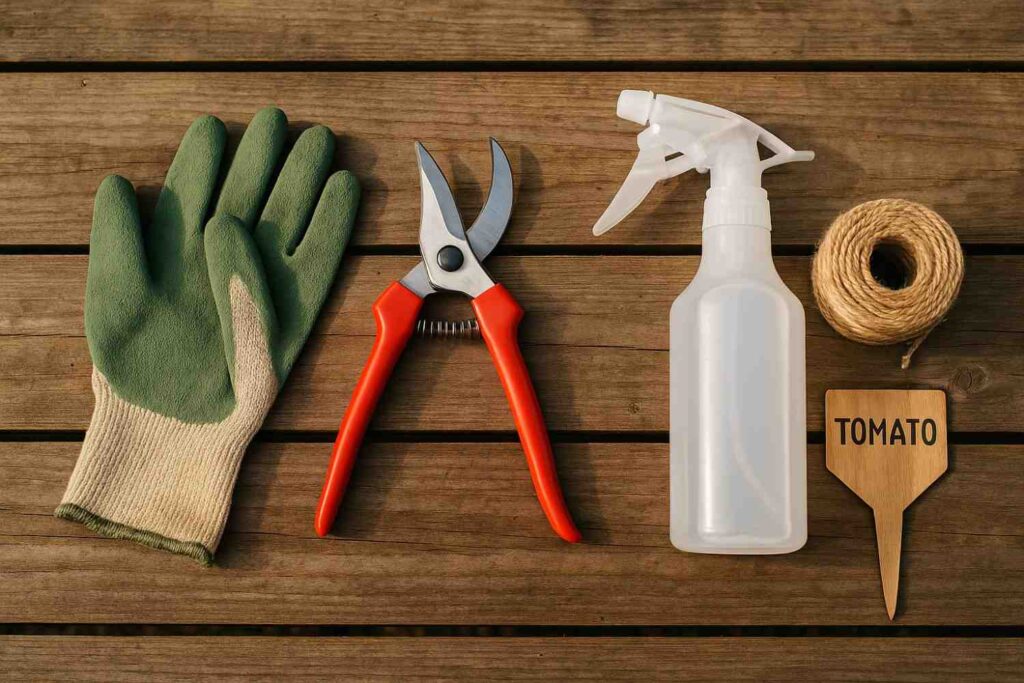
Tools You’ll Need
Gather these tools for clean, safe pruning:
- Pruning Shears: Sharp, clean shears for cutting stems and suckers (bypass shears work best).
- Gloves: Protect your hands from sap, which can irritate skin.
- Disinfectant: Rubbing alcohol or a 10% bleach solution to sterilize tools between cuts.
- Stakes or Cages: Support the plant post-pruning to prevent leaning or breaking.
- Optional: Scissors for small suckers or a soft brush to clean debris.
Sterilize tools before and after use to prevent spreading diseases like bacterial wilt.
Step-by-Step Guide to Pruning Tomato Plants
Follow these steps for effective pruning, tailored to beginners:
Step 1: Identify Suckers
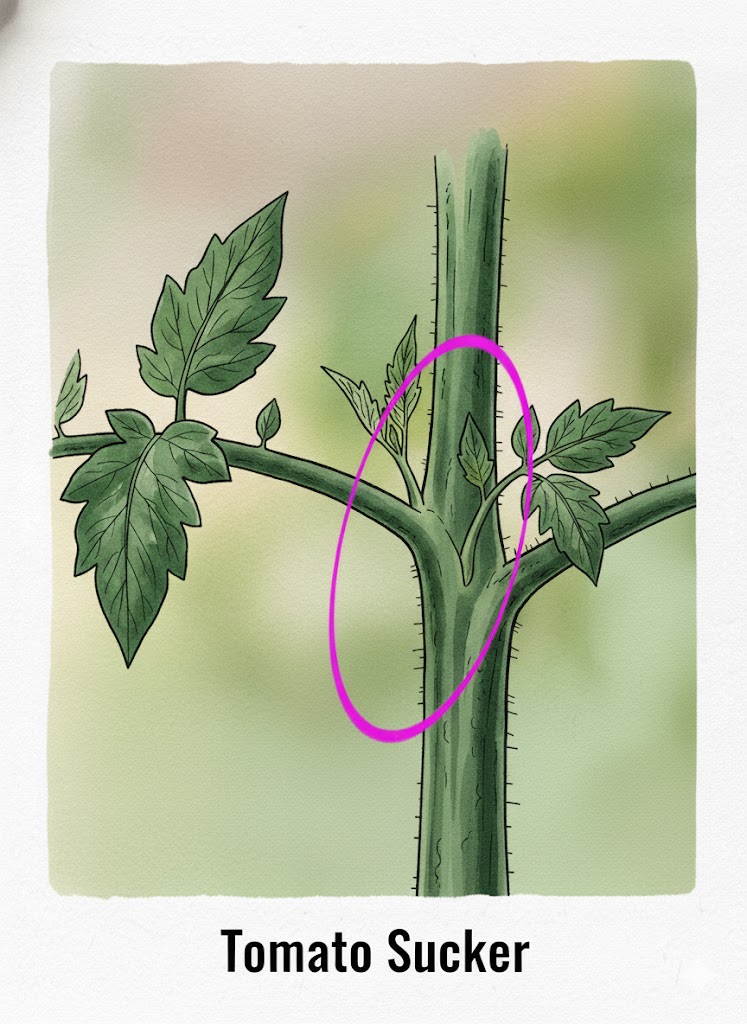
Suckers are small shoots that grow in the “V” between the main stem and branches. They look like mini stems with tiny leaves. While they can produce fruit, they often sap energy from the main plant, reducing overall yield.
- How to Spot Them: Look at the crotch where a leaf branch meets the main stem. Suckers start small (1-2 inches) but grow into full stems if left unchecked.
- Which to Remove: For indeterminate tomatoes, remove most suckers below the first flower cluster to focus energy on fruit. For determinate tomatoes, leave most suckers unless the plant looks overcrowded.
Step 2: Remove Suckers
- By Hand: For suckers under 2 inches, pinch them off with your fingers for a clean break. Twist gently to avoid tearing the stem.
- With Shears: For larger suckers, use sterilized shears to cut close to the main stem without damaging it.
- Tip: Remove suckers when they’re small to minimize plant stress. Check every 7-10 days.
Step 3: Trim Lower Leaves
Leaves touching the soil or within 6-12 inches of the ground can invite diseases like early blight. Use shears to cut these leaves, leaving a clean stub. Aim to keep the bottom of the plant open and airy.
Step 4: Thin Out Dense Foliage
If your plant has thick clusters of leaves blocking sunlight or airflow:
- Identify leaves that overlap or shade fruit clusters.
- Remove 1-2 leaves per branch, starting with yellowing or damaged ones.
- Don’t overdo it—keep at least 50% of the leaves to support photosynthesis.
Step 5: Support the Plant
After pruning, the plant may be top-heavy. Use stakes, cages, or trellises to secure it:
- Tie the main stem loosely to a stake with soft twine.
- Ensure fruit clusters are supported to prevent branches from snapping.
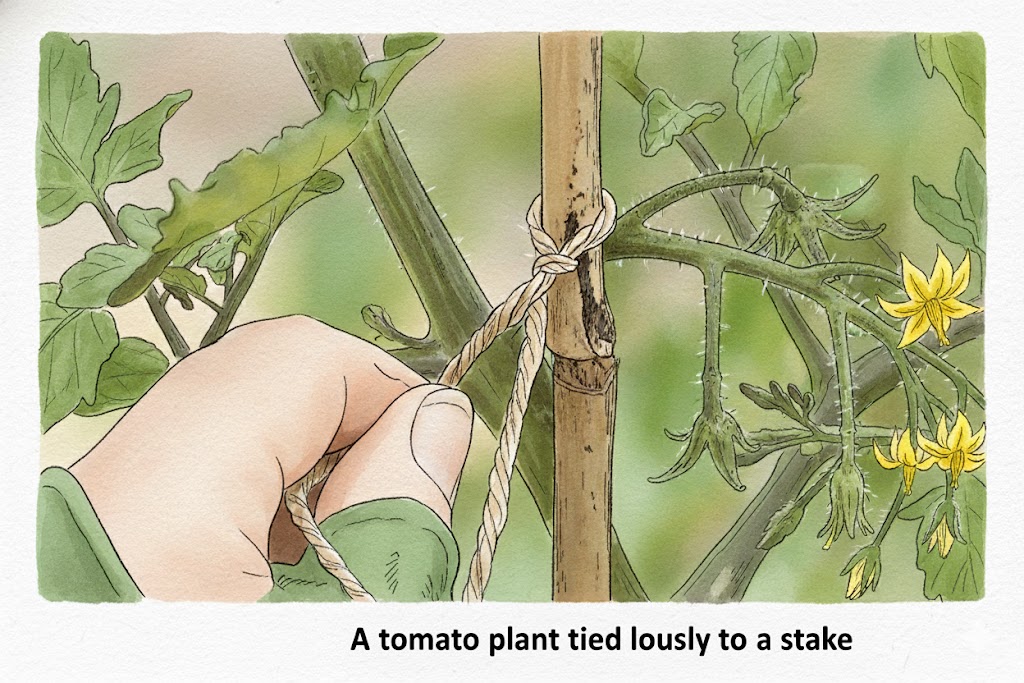
Step 6: Monitor and Maintain
- Check weekly for new suckers, yellow leaves, or signs of disease.
- Water consistently after pruning to help the plant recover.
- Apply a balanced fertilizer (e.g., 10-10-10) every 2-3 weeks to support growth.
Pruning Tips by Tomato Variety
- Indeterminate Varieties:
- Prune to 1-2 main stems for maximum yield.
- Remove all suckers below the first flower cluster and selectively above it.
- Thin foliage to allow light to reach at least 70% of the fruit clusters.
- Determinate Varieties:
- Prune lightly, focusing on lower leaves and overcrowded areas.
- Avoid removing suckers above flower clusters, as they contribute to the main yield.
- Cherry Tomatoes:
- Prune moderately to maintain airflow, as their small fruits ripen faster in sunlight.
- Heirloom Tomatoes:
- Be gentle, as heirlooms are more delicate. Focus on disease prevention by removing lower leaves.
Common Pruning Mistakes to Avoid
Even beginners can prune like pros by steering clear of these pitfalls:
- Over-Pruning: Removing too many leaves (more than 50%) can stress the plant and reduce photosynthesis. Aim for balance.
- Pruning Wet Plants: Wet foliage spreads diseases like blight. Always prune when plants are dry.
- Dirty Tools: Unsterilized shears can introduce pathogens. Clean tools with alcohol between plants.
- Ignoring Plant Type: Pruning determinate tomatoes like indeterminates can slash your yield. Always check the variety.
- Neglecting Support: Pruning without staking can cause branches to break under fruit weight.
Troubleshooting Common Issues
- Yellowing Leaves After Pruning: Likely due to over-pruning or nutrient deficiency. Apply a nitrogen-rich fertilizer and reduce pruning intensity.
- Slow Fruit Ripening: Too little sunlight. Thin out more foliage above fruit clusters.
- Disease Spots (e.g., Blight): Remove affected leaves immediately, dispose of them (don’t compost), and improve airflow with further pruning.
- Wilting: Over-pruning or underwatering. Water deeply and pause pruning for 1-2 weeks.
Seasonal Pruning Calendar
- Spring (March-May):
- Focus: Establish plant structure.
- Tasks: Remove lower leaves, pinch early suckers, stake early.
- Summer (June-August):
- Focus: Maximize airflow and fruit production.
- Tasks: Regular sucker removal, thin dense foliage, monitor for pests.
- Fall (September-November):
- Focus: Support ripening fruit.
- Tasks: Remove new suckers, trim yellow leaves, reduce watering as growth slows.
Advanced Tips for Bigger Yields
- Topping the Plant: In late summer, cut the top of indeterminate plants (above the last fruit cluster) to stop vertical growth and focus energy on ripening.
- Companion Planting: Grow basil or marigolds near tomatoes to deter pests, reducing the need for heavy pruning to control pest-related damage.
- Mulching: Add straw or wood chips under plants to prevent soil splash, reducing disease and the need for lower-leaf pruning.
- Record Keeping: Note which suckers you remove and track yields to refine your pruning strategy each season.
FAQs for Beginners
Q: Can I prune tomatoes without tools?
A: Yes, for small suckers, pinch them off with your fingers. For larger stems, shears are safer and cleaner.
Q: How much pruning is too much?
A: Never remove more than 50% of the leaves or stems at once. Prune gradually over weeks.
Q: Do I need to prune container tomatoes?
A: Yes, especially indeterminate varieties in containers, to control size and improve airflow.
Q: What if I don’t prune at all?
A: Unpruned plants may produce smaller fruits, have more disease, and become unmanageable, especially indeterminates.
Conclusion
Pruning tomato plants doesn’t have to be daunting. With the right tools, timing, and techniques, you can boost your garden’s productivity and grow healthier, tastier tomatoes. Start small, focus on suckers and lower leaves, and check your plants weekly. Over time, you’ll develop an eye for what your tomatoes need to thrive. Happy pruning, and enjoy your bountiful harvest.
